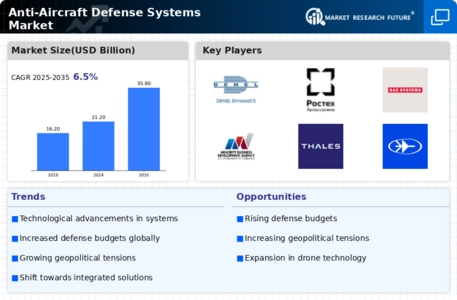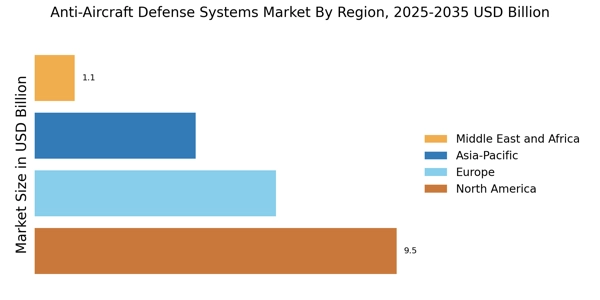Increased Defense Budgets
The Anti-Aircraft Defense Systems Market is bolstered by increased defense budgets across various nations. Governments are recognizing the necessity of robust air defense mechanisms in light of evolving threats. For example, recent data shows that defense expenditures in several countries have surged, with some nations earmarking over 20% of their military budgets for air defense initiatives. This financial commitment is indicative of a broader strategy to enhance national security and deter potential aggressors. As countries prioritize air defense, the market is likely to witness a surge in demand for both new systems and upgrades to existing capabilities.
Rising Geopolitical Tensions
The Anti-Aircraft Defense Systems Market is experiencing heightened demand due to rising geopolitical tensions across various regions. Nations are increasingly investing in advanced defense systems to safeguard their airspace from potential threats. This trend is underscored by military budgets that have seen a notable increase, with many countries allocating significant portions to air defense capabilities. For instance, defense spending in several nations has risen by approximately 5-10% annually, reflecting a strategic pivot towards enhancing aerial security. As threats evolve, the need for sophisticated anti-aircraft systems becomes paramount, driving innovation and procurement in the market.
International Defense Collaborations
The Anti-Aircraft Defense Systems Market is witnessing a surge in international defense collaborations. Countries are increasingly engaging in joint ventures and partnerships to develop and procure advanced air defense systems. These collaborations often lead to shared technology, reduced costs, and enhanced capabilities. For instance, several nations have entered into agreements to co-develop missile defense systems, which not only strengthens bilateral ties but also accelerates innovation in the sector. The trend of collaborative defense initiatives is likely to continue, fostering a more interconnected market landscape and driving growth in the anti-aircraft defense sector.
Technological Advancements in Defense Systems
The Anti-Aircraft Defense Systems Market is significantly influenced by rapid technological advancements. Innovations in radar, missile guidance, and electronic warfare systems are reshaping the landscape of air defense. The integration of artificial intelligence and machine learning into these systems enhances target detection and response times, making them more effective against modern aerial threats. Reports indicate that the market for advanced missile systems is projected to grow at a compound annual growth rate of around 6% over the next five years. This technological evolution not only improves existing systems but also encourages the development of next-generation solutions, thereby expanding market opportunities.
Emerging Threats from Unmanned Aerial Vehicles
The Anti-Aircraft Defense Systems Market is increasingly shaped by the emergence of threats posed by unmanned aerial vehicles (UAVs). The proliferation of drones, both for military and civilian applications, has necessitated the development of specialized anti-aircraft systems capable of countering these agile threats. As UAV technology advances, traditional air defense systems may require enhancements to effectively neutralize these platforms. Market analysts suggest that the demand for counter-drone systems is expected to grow significantly, potentially reaching a market size of several billion dollars within the next few years. This shift indicates a critical area of focus for manufacturers and defense contractors.


















Leave a Comment